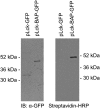A novel biotinylated lipid raft reporter for electron microscopic imaging of plasma membrane microdomains
- PMID: 22822037
- PMCID: PMC3435554
- DOI: 10.1194/jlr.D026468
A novel biotinylated lipid raft reporter for electron microscopic imaging of plasma membrane microdomains
Abstract
The submicroscopic spatial organization of cell surface receptors and plasma membrane signaling molecules is readily characterized by electron microscopy (EM) via immunogold labeling of plasma membrane sheets. Although various signaling molecules have been seen to segregate within plasma membrane microdomains, the biochemical identity of these microdomains and the factors affecting their formation are largely unknown. Lipid rafts are envisioned as submicron membrane subdomains of liquid ordered structure with differing lipid and protein constituents that define their specific varieties. To facilitate EM investigation of inner leaflet lipid rafts and the localization of membrane proteins therein, a unique genetically encoded reporter with the dually acylated raft-targeting motif of the Lck kinase was developed. This reporter, designated Lck-BAP-GFP, incorporates green fluorescent protein (GFP) and biotin acceptor peptide (BAP) modules, with the latter allowing its single-step labeling with streptavidin-gold. Lck-BAP-GFP was metabolically biotinylated in mammalian cells, distributed into low-density detergent-resistant membrane fractions, and was readily detected with avidin-based reagents. In EM images of plasma membrane sheets, the streptavidin-gold-labeled reporter was clustered in 20-50 nm microdomains, presumably representative of inner leaflet lipid rafts. The utility of the reporter was demonstrated in an investigation of the potential lipid raft localization of the epidermal growth factor receptor.
Figures








Similar articles
-
Metabolically Biotinylated Reporters for Electron Microscopic Imaging of Cytoplasmic Membrane Microdomains.Methods Mol Biol. 2016;1376:87-96. doi: 10.1007/978-1-4939-3170-5_8. Methods Mol Biol. 2016. PMID: 26552677
-
Single-molecule microscopy reveals plasma membrane microdomains created by protein-protein networks that exclude or trap signaling molecules in T cells.Cell. 2005 Jun 17;121(6):937-50. doi: 10.1016/j.cell.2005.04.009. Cell. 2005. PMID: 15960980 Free PMC article.
-
The oxygen-substituted palmitic acid analogue, 13-oxypalmitic acid, inhibits Lck localization to lipid rafts and T cell signaling.Biochim Biophys Acta. 2002 Apr 3;1589(2):140-50. doi: 10.1016/s0167-4889(02)00165-9. Biochim Biophys Acta. 2002. PMID: 12007789
-
Lipid rafts: cell surface platforms for T cell signaling.Biol Res. 2002;35(2):127-31. doi: 10.4067/s0716-97602002000200003. Biol Res. 2002. PMID: 12415729 Review.
-
Regulation of T-cell receptor signalling by membrane microdomains.Immunology. 2004 Dec;113(4):413-26. doi: 10.1111/j.1365-2567.2004.01998.x. Immunology. 2004. PMID: 15554919 Free PMC article. Review.
Cited by
-
Dysregulation of cellular membrane homeostasis as a crucial modulator of cancer risk.FEBS J. 2024 Apr;291(7):1299-1352. doi: 10.1111/febs.16665. Epub 2022 Nov 7. FEBS J. 2024. PMID: 36282100 Free PMC article. Review.
-
Annexin A2 mediates apical trafficking of renal Na⁺-K⁺-2Cl⁻ cotransporter.J Biol Chem. 2014 Apr 4;289(14):9983-97. doi: 10.1074/jbc.M113.540948. Epub 2014 Feb 13. J Biol Chem. 2014. PMID: 24526686 Free PMC article.
-
Plasma membrane compartmentalization of D2 dopamine receptors.J Biol Chem. 2013 May 3;288(18):12554-68. doi: 10.1074/jbc.M112.443945. Epub 2013 Mar 14. J Biol Chem. 2013. PMID: 23493394 Free PMC article.
-
Visualization of phosphatidic acid fluctuations in the plasma membrane of living cells.PLoS One. 2014 Jul 15;9(7):e102526. doi: 10.1371/journal.pone.0102526. eCollection 2014. PLoS One. 2014. PMID: 25025521 Free PMC article.
-
Functional link between plasma membrane spatiotemporal dynamics, cancer biology, and dietary membrane-altering agents.Cancer Metastasis Rev. 2018 Sep;37(2-3):519-544. doi: 10.1007/s10555-018-9733-1. Cancer Metastasis Rev. 2018. PMID: 29860560 Free PMC article. Review.
References
-
- Simons K., Toomre D. 2000. Lipid rafts and signal transduction. Nat. Rev. Mol. Cell Biol. 1: 31–39 - PubMed
-
- Tian T., Harding A., Inder K., Plowman S., Parton R. G., Hancock J. F. 2007. Plasma membrane nanoswitches generate high-fidelity Ras signal transduction. Nat. Cell Biol. 9: 905–914 - PubMed
-
- Wilson B. S., Pfeiffer J. R., Oliver J. M. 2002. FcepsilonRI signaling observed from the inside of the mast cell membrane. Mol. Immunol. 38: 1259–1268 - PubMed
Publication types
MeSH terms
Substances
Grants and funding
LinkOut - more resources
Full Text Sources
Research Materials
Miscellaneous

